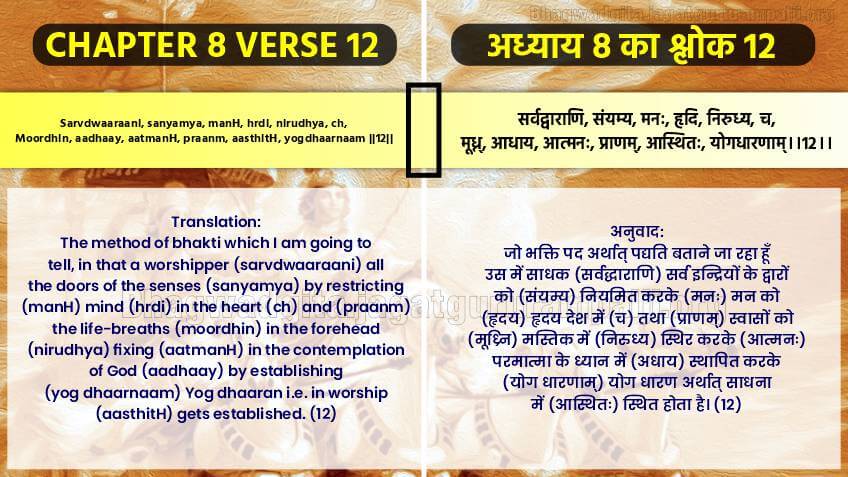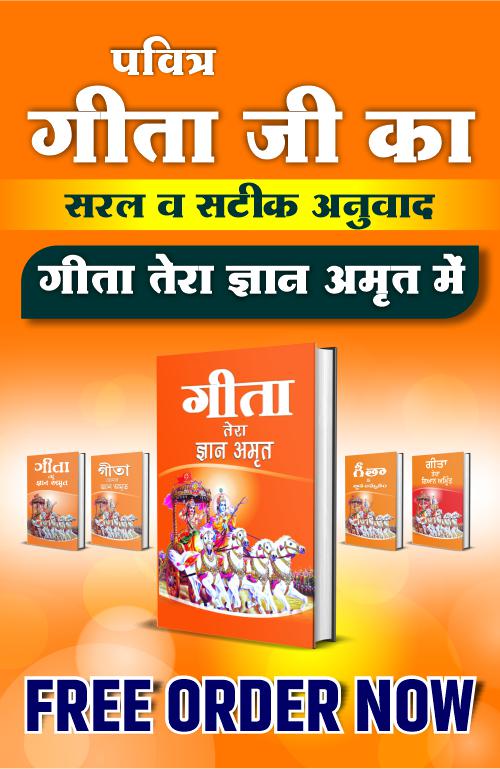
Sarvdwaaraani, sanyamya, manH, hrdi, nirudhya, ch,
Moordhin, aadhaay, aatmanH, praanm, aasthitH, yogdhaarnaam ||12||
Translation: The method of bhakti which I am going to tell, in that a worshipper (sarvdwaaraani) all the doors of the senses (sanyamya) by restricting (manH) mind (hrdi) in the heart (ch) and (praanm) the life-breaths (moordhin) in the forehead (nirudhya) fixing (aatmanH) in the contemplation of God (aadhaay) by establishing (yog dhaarnaam) Yog dhaaran i.e. in worship (aasthitH) gets established. (12)
Translation
The method of bhakti which I am going to tell, in that a worshipper restraining all the doors of the senses, fixing the mind in heart and the life-breaths in the forehead, establishing in the contemplation of God, gets established in yog dhaaran i.e. in worship.
Meaning
The giver of the knowledge of Gita, Kaal God, is only saying in brief in allusive manner that in the method of bhakti for attaining the Complete God, a worshipper does sadhna through breaths. The jaap of three mantras Om – Tat – Sat which has been mentioned in Gita Adhyay 17 Shlok 23, one does its practice in forehead and heart by equalising mind-air i.e. breaths and concentration and attention. Like, the jaap of Satnaam is done through breaths. There are two words in Satyanaam: one word is Om (ॐ) and second Tat which is a secret. Om (ॐ) mantra is jaap of Brahm. The place of Brahm is Sahastr lotus which is behind the forehead, and Purna Parmatma (Complete/Supreme God) resides in a special manner in the heart (like, the sun in water). Therefore, in the sumiran of Satyanaam, by focussing the attention on breaths, the mantras are repeated in forehead and heart with attention along with breaths. Kaal God does not know about the complete method of bhakti. In the next Shlok 13, he has only told the method of his way of worship.
सर्वद्वाराणि, संयम्य, मनः, हृदि, निरुध्य, च,
मू£ध्न्, आधाय, आत्मनः, प्राणम्, आस्थितः, योगधारणाम्।।12।।
अनुवाद: जो भक्ति पद अर्थात् पद्यति बताने जा रहा हूँ उस में साधक (सर्वद्धाराणि) सर्व इन्द्रियों के द्वारों को (संयम्य) नियमित करके (मनः) मन को (हृदय) हृदय देश में (च) तथा (प्राणम्) स्वासों को (मूध्र्नि) मस्तिक में (निरुध्य) स्थिर करके (आत्मनः) परमात्मा के ध्यान में (अधाय) स्थापित करके (योग धारणाम्) योग धारण अर्थात् साधना में (आस्थितः) स्थित होता है। (12)
केवल हिन्दी अनुवाद:--जो भक्ति पद अर्थात् पद्यति बताने जा रहा हूँ उस में साधक सर्व इन्द्रियों के द्वारों को नियमित करके मन को हृदय देश में तथा स्वासों को मस्तिक में स्थिर करके परमात्मा के ध्यान में स्थापित करके योग धारण अर्थात् साधना में स्थित होता है।
भावार्थ: गीता ज्ञान दाता काल भगवान केवल संक्षेप में संकेत द्वारा कह रहा है कि पूर्ण परमात्मा को प्राप्त करने वाली भक्ति पद्धती में साधक स्वासों द्वारा साधना करता है। गीता अध्याय 17 श्लोक 23 में ओं-तत्-सत् जो तीन मन्त्रा का जाप है उसका मन-पवन अर्थात् स्वासों व सुरति व निरति को सम करके मस्तिक तथा हृदय में अभ्यास करता है। जैसे सतनाम के जाप को स्वासों द्वारा किया जाता है। सत्यनाम में दो अक्षर होते हैं एक अक्षर ओं (ॐ) तथा दूसरा तत् जो गुप्त है। ओं (ॐ) नाम ब्रह्म का जाप है। ब्रह्म का स्थान संहस्त्रा कमल है जो मस्तिक के पीछे है तथा पूर्ण परमात्मा विशेष रूप से हृदय में (जल में सूर्य की तरह) निवास करता है। इसलिए सत्यनाम के सुमरण में स्वांस पर ध्यान एकाग्र करके मस्तिक व हृदय में स्वांस के साथ ध्यान से नामों का जाप किया जाता है। काल भगवान को पूर्ण भक्ति विधि का ज्ञान नहीं है। अगले श्लोक 13 में केवल अपनी साधना की विधि बताई है।
